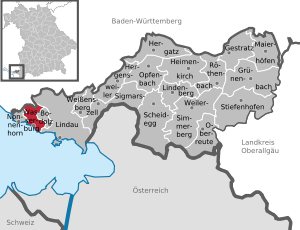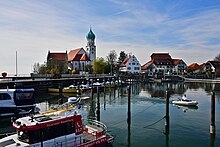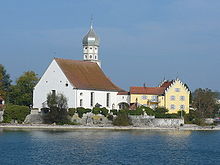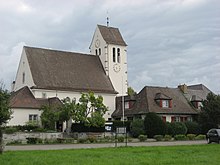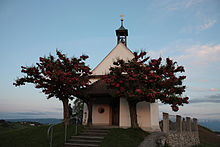Wasserburg (Lake Constance)
| coat of arms | Germany map | |
|---|---|---|

|
Coordinates: 47 ° 34 ' N , 9 ° 38' E |
|
| Basic data | ||
| State : | Bavaria | |
| Administrative region : | Swabia | |
| County : | Lindau (Lake Constance) | |
| Height : | 399 m above sea level NHN | |
| Area : | 6.34 km 2 | |
| Residents: | 3846 (Dec. 31, 2019) | |
| Population density : | 607 inhabitants per km 2 | |
| Postal code : | 88142 | |
| Area code : | 08382 | |
| License plate : | LI | |
| Community key : | 09 7 76 128 | |
| Community structure: | 8 parts of the community | |
| Address of the municipal administration: |
Lindenplatz 1 88142 Wasserburg (Lake Constance) |
|
| Website : | ||
| Mayor : | Harald Voigt (Free Citizenship of Wasserburg) | |
| Location of the municipality of Wasserburg (Bodensee) in the district of Lindau (Bodensee) | ||
Wasserburg (Bodensee) is a municipality in the Swabian district of Lindau (Bodensee) . The state-approved climatic health resort is one of three Bavarian communities on the shores of Lake Constance .
geography
location
Wasserburg is located on the north shore of Lake Constance, five kilometers west of the Bavarian district town of Lindau (Bodensee) and east of the municipality of Nonnenhorn , which also belongs to Bavaria. To the north, the Bodenseekreis borders the municipality, to the east, next to Lindau, also the municipality of Bodolz .
Parish parts
The municipality has eight officially named parts of the municipality :
Wasserburg district:
District Hege:
The Wasserburg peninsula with church and castle is around 2.3 hectares in size.
The community was initially called Mitten and was officially renamed Wasserburg (Bodensee) on March 23, 1926 . The place Wasserburg initially only consisted of the peninsula. From 1925, the place name also referred to the village of Mitten in the north. On January 1, 1972, the previously independent municipality of Hege was incorporated.
history
Until the 17th century
| Moated castle | |
|---|---|
|
Moated castle with church and castle, around 1900 |
|
| Creation time : | around 8th century, fortresses 13th century, 1540s Renaissance castle |
| Castle type : | Inselburg |
| Conservation status: | in operation (hotel); medieval Tower house preserved |
| Place: | Wasserburg on Lake Constance |
| Geographical location | 47 ° 34 '2.1 " N , 9 ° 37' 46" E |
In 784, the name "wazzarburuc" appeared for the first time in a document from the St. Gallen monastery . In the 10th century, this island fortress served as a refuge for the monasteries of St. Gallen. It is believed that the Hungarians dared an attack with fire and sword on the Sankt Gallen monastery fortress Wasserburg between 925 and 955, which, however, could possibly be repulsed despite a fire on the Vorberg. Traces of the excavations carried out in 1993 indicate this. This document mentions a church of St. George belonging to the St. Gallen monastery. Until 1280 the Lords of Kisslegg, as ministers of the monastery, were responsible for the rule of Wasserburg , then the rule went to the Lords of Schellenberg for 500 silver marks. They built the moated castle as a Sankt Gallen fiefdom (until 1826) into a fortress.
On June 24, 1358 the Wasserburg fortress was reduced to rubble by the troops of the city union. In 1386 Wasserburg came to the Counts of Montfort for 650 pounds Heller through the mediation of the Counts of Ebersberg . From the 1450s the branch line Montfort- Rothenfels- Wasserburg (Hugo XIII.) Was formed here .
In 1519 there was a plague epidemic in Freiburg . In January 1519 the classes for the students were therefore relocated to the Bodensee in Wasserburg, Lindau and Konstanz for a period of one year. In 1537 and 1555, the Counts of Montfort had a new Renaissance castle built.
The heavily indebted Counts of Montfort sold Wasserburg in 1592 for 63,000 guilders to Counts Fugger von Kirchberg and Weißenhorn zu Babenhausen. Between 1655 and 1664, under Fugger rule, witch hunts took place in Wasserburg , which killed at least 25 people.
18th and 19th centuries
In 1720 the Fuggers built a connecting dam to the island. A sandstone pillar reminds of the loss of the island quality. On February 17, 1750, the west wing of the castle was completely destroyed by fire.
Because of high debts, the Fuggers ceded the rule of Wasserburg to the ore house of Austria in 1755. The Austrians set up a post office in the hamlet of Bichel in order to have an Austrian post office on the lake in addition to the Mailänder Bote in Lindau .
In the course of the coalition wars (1792–1805), naval warfare raged on Lake Constance in 1799 and 1800, also in front of Wasserburg. On May 11, 1800, Bregenz was finally occupied by the French who had advanced over southwest Germany.
Wasserburg belonged to Upper Austria until the area came to the Electorate of Bavaria after the Peace of Pressburg on December 26, 1805 , which became the Kingdom of Bavaria on January 1, 1806 . In 1826 the wine fee to the monastery of Sankt Gallen was lifted. In 1872 a steamboat landing stage was built and in 1899 the place received a train station on the Friedrichshafen – Lindau railway line .
20th and 21st centuries
From 1911/12 there was electric light in Wasserburg. The year 2009 was dominated by the 1225th anniversary of the first mention of Wasserburg. As part of the anniversary, an exhibition of the approximately one meter tall United Buddy Bears took place on the Wasserburg peninsula in the summer months of August and September .
In the spring of 2018, the Bronze Age " Wasserburger Dugout " was recovered from the Eschbach estuary in front of the Wasserburger Ufer, the largest and oldest means of transport ever found on Lake Constance. The dendrochronological age determination showed that the watercraft is around 3,150 years old.
Population development
Between 1988 and 2018, the municipality grew by 1094 inhabitants from 2731 to 3825 or 40.1%, which is the highest percentage increase in the period mentioned in the entire district.
Population development in Wasserburg (Lake Constance)
Source: Bavarian State Office for Statistics

politics
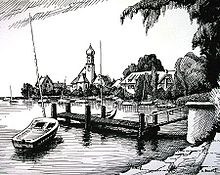
Municipal council
In the local elections on March 16, 2014 , the seats in the municipal council of Wasserburg were distributed among the individual parties and lists as follows:
| Party / list | Seats |
| Christian Social Union (CSU) | 6 seats |
| Free citizenship Wasserburg | 7 seats |
| Independent list Wasserburg | 3 seats |
mayor
The professional first mayor is Harald Voigt (Free Citizenship of Wasserburg). He achieved 72.5% of the valid votes in the first ballot in the 2020 mayoral election and has been in office since May 1, 2020.
- 1978–1990: Willi Stadler
- 1990-2002: Peter Cicholinski
- 2002–2011: Thomas Eigstler (CSU and Free Voters)
- 2011–2020: Thomas Kleinschmidt (Active Citizens and Free Citizenship of Wasserburg)
- 2020– : Harald Voigt
coat of arms
The current coat of arms was awarded in 1954 by the Lindau District Presidium. It depicts a shield divided from silver-white over blue: on top of silver-white is an armored bear (Bär von St. Gallen ) looking to the left , below on blue is a castle standing in the water.
- The depiction of the bear of St. Gallen is an indication that the St. George's Church belonged to the St. Gallen monastery.
- The castle represents the Wasserburg Castle - a gift from the grateful abbot of St. Gallen in 1537 to Count Hugo von Montfort , who acted as a mediator in the peasant war .
- The colors white and blue express the current affiliation of the municipality to the state of Bavaria.
Religions
The parish community Wasserburg comprises the three parishes of St. John the Baptist in Bodolz , St. Christophorus in Nonnenhorn and St. Georg in Wasserburg.
Attractions
Wasserburg's hallmark is its picturesque peninsula , on which the St. Georg Church , Wasserburg Castle and the Malhaus (former court house - now houses a museum) are located.
At the same time, there is also the shipping pier from which passenger ships sail to Lindau , Bregenz ( A ), Konstanz and Rorschach ( CH ), as well as the fishing port and the sports boat port. From Wasserburg you have a unique view of the mountains of Switzerland, Liechtenstein and Austria.
Churches and chapels
- Catholic parish church of St. George
The first church on Wasserburg Island, mentioned in 784, was probably made of wood. Today's choir (chancel) emerged from a previous Gothic building (around 1400), which probably also included the substructure of the originally pointed church tower. In the 17th century, the tower of St. George's Church was given a Welsche dome in the style of the Augsburg builder Elias Holl .
The interior is decorated with a baroque high altar with life-size figures of Saints Gallus and Otmar. An epitaph of Count Fugger Leopold can be found above the sacristy door. Stone tablets on three of the four main pillars recall the Seegfrörnen from 1573, 1830 and 1963. The ceiling frescoes (1918/19) by Otto Hämmerle (* 1881 until after 1944) with motifs from the history of Wasserburg and the richly decorated organ work are remarkable .
- St. James Chapel in Reutenen
The small " Gfrörnenkapelle " was built in 1643 and consecrated to St. James . It was probably originally built as a plague chapel (Gfrörnen = plague bumps), the atrocities of the Thirty Years' War may have been another reason for the construction of such a votive chapel . The chapel is made of sandstone blocks, field stones and Lake Constance walls, the roof is covered with hand-painted beaver tails and Rorschacher sandstone is laid on the floor .
In 2004 the chapel in the Reutenen district was thoroughly and sensitively renovated on a private initiative, the existing works of art were preserved in their substance. Today a popular Madonna figure and Saint Leonhard shine in new splendor.
- Anthony's Chapel
The Antonius Chapel, first mentioned in 1492 in the Selmnau district, was originally a hermitage. In its current form, the chapel was built in baroque style in 1696. The furnishings include a Gothic Madonna figure and several baroque sculptures. The chapel stands on a moraine hill that offers a wide view over Lake Constance.
- Evangelical Church of St. John
The church named after John the Evangelist was consecrated on November 11, 1937. Since then, evangelical services have been held in this church every Sunday and public holiday.
In the interior, the winged altar by the Munich artist Karl Hemmeter , the wooden "Our Father Frieze" on the side walls and a monolithic font are particularly noteworthy.
Other structures
The model manufacturer NOCH GmbH & Co. KG - Wangen im Allgäu - presented a kit for the fire station (1904), the fire station, without the current attachments. It is still used as a fire station.
- Wasserburg Castle
In the center of the peninsula is the Wasserburg Castle - built between 1537 and 1555 by the Montforters as a renaissance castle instead of an earlier castle of the Lords of Schellenberg , as a three-wing complex.
On February 17, 1750, the west wing was completely destroyed by fire and no longer rebuilt.
The castle building has walls up to three meters thick, has been privately owned by the Köberle family since 1812 and today houses a hotel and restaurant.
- Museum in the painting house
The museum in the Malhaus was built in 1597, was formerly a courthouse of the Fuggers and since 1979 has housed the "Museum in the Malhaus". It is located on the peninsula, right next to the landing stage of the Lake Constance shipping company .
Architectural monuments
Protected areas

In the eastern municipal area, near the border with Bodolz , located in the nature reserve Bichelweiher and Bichelweihermoos the Bichelweiher , a former mill pond.
Three other Wasserburger nature reserves, parts of the European network of protected areas Natura 2000 designated Wasserburger shore of Lake Constance and the habitat trail Birkenried are eight stations of the Bodensee path connected.
Mittelseemoos nature reserve
Information on the Mittelseemoos nature reserve is available at the hiking car park on the road to Hengnau . It is one of the most species-rich flat moors in the Lindau district. Formed by the Wurm Age about 15,000 years ago originated in this landscape moraine , which silted up over time and became a bog. Due to the annual mowing in September, the area does not become bushy and the biodiversity is preserved. Here you can find broad-leaved cotton grass , marsh stendrums or shuttleworths cattail , blue gentian ants , red -backed killer , swamp darter or marsh warbler .
Birkenried biotope nature trail
Nine stations provide the visitor to the educational trail established in 1996 in the Birkenried - the name is derived from " clearing a birch forest " - information on tall herbaceous corridors , pools , dead wood , nesting aids for insects and the Eschbach stream flowing through the area with oxbows, willow bushes , piles of stones and benjes hedge .
In Birkenried many bird and dragonfly species, such as the can reed warbler or the common darter are observed.
Economy and Infrastructure
Wasserburg with its 3500 inhabitants (as of December 2011) is today mainly characterized by tourism and fruit growing.
tourism
The community has a campsite, a lido with heated swimming pool , boat rental and a sailing school. Numerous hotels, guest houses and private quarters offer more than 1700 guest beds.
As a municipality located directly on the lake, Wasserburg is also the starting point for the Lake Constance cycle path and the Lake Constance circular path .
Fruit and wine growing
Wasserburg different types of fruit growing is widespread of pome fruit cultivation with various apple and pear varieties. The community is also the wine-growing area of the Bavarian Lake Constance in the wine-growing region Württemberg .
fishing
Lake Constance fishermen supply the restaurants with fresh Lake Constance fish , especially whitefish . In Wasserburg, fishing was only documented as a livelihood at the beginning of the 20th century, as it was, along with hunting, always a privilege of the aristocratic rulers.
leisure
The Sumserhalle is used for sporting activities as well as for cultural events and is located on the lake shore by the Aquamarin outdoor pool . The name is derived from the main character Augustin Sumser in Horst Wolfram Geissler's novel "Der liebe Augustin".
traffic
railroad
Wasserburg has a stopping point on the railway line Friedrichshafen-Lindau the hour from the local train line Friedrichshafen Harbor - Lindau main station is operated. In addition, trains on the regional express line Stuttgart Hauptbahnhof - Ulm Hauptbahnhof - Friedrichshafen City - Lindau Hauptbahnhof stop in Wasserburg every two hours . The Bodenseegürtelbahn is to come under contact wire by 2021 as part of the electrification of the Southern Railway .
Transportation
Bus 21 runs between Wasserburg and Lindau. It also connects the districts of Hengnau, Hege and Hattnau to local public transport.
shipping
Wasserburg has a port on the peninsula with a landing stage for the liner ships of Lake Constance shipping. Between April and October several liners operate between Konstanz and Bregenz as well as individual ships from Rorschach to Lindau.
Road traffic
The federal road 31 touches the municipality in the north. However, it does not have its own exit from the expressway-like main road. The next slopes are in Kressbronn or Lindau. The old B 31 now bears the official name Kreisstraße LI 16 and leads from Kressbronn via Nonnenhorn, Wasserburg and Enzisweiler to Lindau.
Personalities
Honorary citizen
- 1984: Martin Walser (* 1927 in Wasserburg), writer
- Horst Wolfram Geissler (1893–1983), writer, buried in Wasserburg
Sons and daughters of the church
- Rudolf Agricola (1490–1521), crowned poet by Emperor Maximilian I.
Personalities who have worked in the place
- Franz Xaver Löffler (1875–1955), painter and graphic artist
- Horst Wolfram Geißler (1893–1983), writer (“Der liebe Augustin”) and water burger by choice
literature
- Karl Heinz Burmeister : Wasserburg as a cultural center of the late 13th century , in: Writings of the Association for the History of Lake Constance and its Surroundings , 118th year 2000, pp. 17-27 ( digitized version )
- Waldemar Sensburg: Wasserburg am Bodensee , in: Writings of the Association for the History of Lake Constance and its Surroundings , 28th year 1899, pp. 110–114 ( digitized version )
- Martin Walser: His novel A springing fountain describes life in Wasserburg at the time of National Socialism.
Web links
- Entry on the coat of arms of Wasserburg (Bodensee) in the database of the House of Bavarian History
Individual evidence
- ↑ "Data 2" sheet, Statistical Report A1200C 202041 Population of the municipalities, districts and administrative districts 1st quarter 2020 (population based on the 2011 census) ( help ).
- ↑ a b Mayor / Lord Mayor in municipalities belonging to the district (as of May 1st, 2020). (xlsx) Bavarian State Office for Statistics, accessed on June 20, 2020 .
- ^ Municipality of Wasserburg (Lake Constance) in the local database of the Bavarian State Library Online . Bayerische Staatsbibliothek, accessed on August 18, 2019.
- ↑ a b Wilhelm Volkert (Ed.): Handbook of the Bavarian offices, communities and courts 1799–1980 . CH Beck, Munich 1983, ISBN 3-406-09669-7 , p. 513 .
- ↑ Historical Atlas of Bavaria
- ↑ Fridolin Altweck, local home keeper: 20 years ago: The excavation of the old moated castle . In Museum im Malhaus , accessed on May 7, 2018
- ^ Karl Heinz Burmeister : The Freiburg University in Exile in Wasserburg 1519 . In the yearbook of the district of Lindau , 18 (2003), pp. 46–54
- ^ Manfred Tschaikner, Karl Heinz Burmeister : The Fuggerian rule Wasserburg and the witch hunts . Kunstverlag Fink, Lindenberg 2008, ISBN 978-3-89870-506-6
- ^ KHB: The French Wars 1792–1805. In: Vorarlberg Chronik / Vorarlberg Online , accessed on May 7, 2018
- ^ Pictures from the United Buddy Bears exhibition in Wasserburg . In buddy-fans.de , 2009
- ↑ Hildegard Nagler: Bronze Age boat from Lake Constance is now being preserved . In schwaebische.de , April 12, 2018, with video and picture gallery
- ↑ dpa : Bavaria's oldest boat recovered from Lake Constance after 3100 years . In Heilbronn's voice , April 12, 2018
- ^ Bavarian State Office for Statistics. Retrieved March 14, 2020 .
- ^ Members of the Wasserburg municipal council after the 2014 municipal elections. In the Wasserburg municipality , accessed on May 7, 2018. See: Members of the Wasserburg municipal council after the 2008 municipal elections ( Memento from May 30, 2011 in the Internet Archive ). In the municipality of Wasserburg
- ↑ Thomas Kleinschmidt remains mayor . In schwaebische.de , January 22, 2017
- ^ Municipality of Wasserburg (Lake Constance) . In House of Bavarian History ( HdBG ), Bavaria's municipalities: coat of arms, history, geography
- ^ Parish community Wasserburg , In the Diocese of Augsburg , accessed on May 7, 2018
- ↑ Excerpt from: Fridolin Altweck: Wasserburg am Bodensee . Kunstverlag Josef Fink, Lindenberg 2006, ISBN 3-89870-329-0
- ↑ Wasserburg's fire station is now available in miniature format - a model is handed over to the fire brigade commander . Schwäbische Zeitung from August 21, 2018
- ^ Castle Wasserburg (Lake Constance) . In the municipality of Wasserburg
- ^ Martin Glase: Electrification Ulm - Friedrichshafen - Lindau-Aeschach. (PDF) (No longer available online.) In: DB Netz AG. December 4, 2017, archived from the original on May 1, 2018 ; accessed on April 30, 2018 . Info: The archive link was inserted automatically and has not yet been checked. Please check the original and archive link according to the instructions and then remove this notice.

